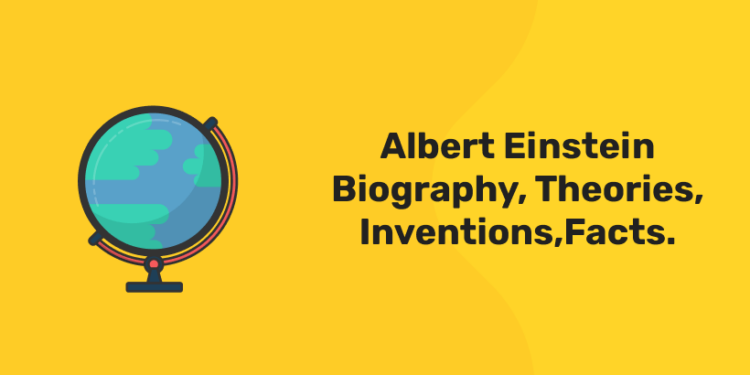Table of Contents
Albert Einstein was one of the finest intellectuals and scientists of the twentieth century. His discoveries transformed physics and forever changed mankind’s knowledge of the universe’s fundamental workings, ushering in the atomic age. The spectacular confirmation of Einstein’s theories in 1919 catapulted him into unanticipated popularity, and he swiftly established himself as an international symbol of wisdom and brilliance.
Despite being shy in social situations, Einstein vowed to use his newfound popularity to speak out on the political and social issues that were most important to him. From the early 1920s until his death in 1955, Einstein was a prominent voice against nationalism, militarism, and anti-Semitism—the evil elements that tainted his background as a German Jew and prompted him to resign his German citizenship on two separate occasions. After escaping Hitler’s Germany in 1933, Einstein lived in America and spent the final 22 years of his life in Princeton, New Jersey, where he worked until his death to develop a “unified field” theory that might explain all of nature’s forces in a single equation.
Life of Albert Einstein
Einstein was born on March 14, 1879, in Ulm, Germany, a city with a population of little over 120,000 people today. Where his house used to be, there is a modest commemorative plaque (it was destroyed during World War II). According to the Nobel Prize website, his family relocated to Munich immediately after his birth and then to Italy when his father ran into financial difficulties. Albert and his younger sister, Maria, were raised by Einstein’s father, Hermann, who managed an electrochemical firm, and his mother, Pauline.
According to Hans-Josef Küpper, an Albert Einstein expert, Einstein would write in his memoirs that two “wonders” had a profound impact on his early years. At the age of five, Einstein saw his first wonder, a compass, and was astounded that invisible forces could deflect the needle. This would pique his interest in unseen powers for the rest of his life. The second wonder came when he was 12 years old and discovered a book of geometry that he adored and dubbed his “holy geometry book.”
Watch Video lectures for Science! Download Entri App!
Albert Einstein Family
1: Who was the first woman President of India?
Albert Einstein was born into a secular Jewish family and had a two-year-younger sister named Maja. Milena Maric, a Serbian physics student whom Einstein met at school in Zürich, married him in 1903. They had three children: Lieserl, a daughter, and Hans and Eduard, two sons. In 1919, Einstein and Maric divorced after a period of strife. During his marriage, Einstein had started an affair with his cousin Elsa Löwenthal. In 1919, they married, the same year he divorced Maric.
Free UPSKILLING Courses!
Take your first step toward mastering in-demand skills, acing interviews, and securing top-tier jobs with Entri's free upskilling courses.
Start Learning!Albert Einstein Childhood
Albert Einstein was not a typical child, as one might anticipate. But not in the way you might expect. He was not a child prodigy who could read at the age of two and perform advanced math at the age of four, but rather the polar opposite. Albert appeared to be having a hard time learning to speak. Albert recalls as a child that his parents were so concerned about his speech problems that they sought medical advice. Albert had an odd habit of repeating things to himself multiple times even when he did start talking. He was once known as “der Depperte,” which translates to “dopey one.”
Einstein developed a defiant attitude against his teachers and authorities in general as he grew older and started school. Perhaps it was due to a lack of ability to articulate one’s intelligence. His first school was a Catholic school, where the teachers were kind to him, but he was often teased by his classmates because he was Jewish. He eventually began to excel in school, and, contrary to popular belief, he did not flunk out of math. Instead, he consistently performed at the top of his class.
Albert would subsequently speculate that his early challenges may have contributed to his ability to think differently and produce new scientific concepts. He preferred to think in images rather than words. He also loves defying convention and thinking about things in unusual ways.
Albert Einstein Education
Due to his outstanding mathematics and physics results on the entrance exam, Einstein was eventually accepted into the Swiss Federal Institute of Technology in Zurich.He still needed to finish his pre-university education first, so he went to Jost Winteler’s high school in Aarau, Switzerland. Einstein lived with the schoolmaster’s family and was smitten by Marie Winteler, the schoolmaster’s daughter. At the turn of the century, Einstein abandoned his German citizenship and became a Swiss citizen.
After graduating, Einstein had a difficult time securing academic posts since he had alienated several teachers by not attending class more frequently in favour of studying on his own.After receiving a referral for a clerk position in a Swiss patent office in 1902, Einstein was able to find stable work. While working at the patent office, Einstein had the opportunity to expand on concepts that he had developed during his studies at the Swiss Federal Institute of Technology, cementing his theorems on what would become known as the principle of relativity.
In 1905—seen by many as a “miracle year” for the theorist—The Annalen der Physik, one of the most well-known physics magazines of the time, published four publications by Einstein. The photoelectric effect and Brownian motion were the subjects of two of the studies. The other two, which outlined E=MC2 and the special theory of relativity, were pivotal in Einstein’s career and in the development of science.
Attempt General Knowledge Quiz! Download Entri App!
Albert Einstein’s Theories/Inventions
Albert Einstein is widely regarded as a genius and one of the greatest thinkers of all time. Despite the fact that he isn’t as well-known for innovations as Thomas Edison or Nikola Tesla, Einstein’s physics theories and thoughts are still influential today.
He devoted much of his life studying relativity ideas, looking into space, time, matter, and energy. So, what were the most important theories of Albert Einstein? Here are some of Albert Einstein’s most notable accomplishments as we reflect on this remarkable thinker.
General Theory of Relativity
Einstein’s General Theory of Relativity was published in 1916. This work applies Special Relativity and Newton’s Law of Universal Gravitation to describe gravity as a spatial and temporal feature. This idea has assisted our understanding of how the universe’s large-scale structure is constructed.
This is how the Theory of General Relativity can be explained:
Newton contributed to the quantification of gravity between two things as a dragging of two bodies, regardless of their mass or distance apart.
The principles of physics are constant for all non-accelerating observers, and the speed of light is constant no matter how quickly the observer moves, according to Einstein. He discovered that space and time are intertwined, and that events that happen at one time for one observer may happen at a different time for another.
As a result, he theorized that enormous objects in space may cause spacetime to deform.
Modern physicists have used Einstein’s predictions to research and understand black holes and gravitational lensing.
Quantum Theory of Light
All light, according to Einstein’s theory of light, is made up of small packets of energy called photons. He proposed that these photons were particles with wave-like qualities, which was a completely novel concept at the time.
He also spent some time explaining how metals emit electrons when they are struck by big electric pulses, such as lightning.
Special Theory of Relativity
During Einstein’s research, he began to observe discrepancies in Newtonian mechanics’ relationship to electromagnetic, particularly Maxwell’s equations. He presented a new method of thinking about the physics of objects nearing the speed of light in an article published in September 1905.
Einstein’s Special Theory of Relativity was named after this concept. It shifted the way people thought about physics at the time.
Einstein discovered that observers in relative motion have different perceptions of time. He observed that two events can occur at the same time from the perspective of one observer, but at different times from the perspective of the other. And both of them would be correct.
Avogadro’s Number
Avogadro’s number should be familiar to anyone who has completed a high school chemistry course
Einstein confirmed the existence of atoms and laid the framework for determining Avogadro’s number, the number of atoms in one mole of molecule or an element, while working on his mathematical model for understanding Brownian motion, the erratic movement of particles in a fluid.
The presence of tiny indistinguishable particles was suggested by Einstein’s work on Brownian motion. Jean Perrin later proved this hypothesis by conducting experiments with a high-precision microscope to corroborate Einstein’s mathematical work. Perrin was able to compute Avogadro’s number and verify the existence of atoms as a result of this, for which he was awarded the Nobel Prize in 1926.
The Photoelectric Effect
Scientists had seen this behavior but had been unable to reconcile the result with Maxwell’s wave theory of light. Einstein’s theory of the Photoelectric Effect explains the emission of electrons from metal when light shines on it.
His photon hypothesis helps in the comprehension of this phenomenon. He proposed that when light strikes an item, it emits photoelectrons, which he called photoelectrons.
This model underpins how solar cells work: light causes atoms to release electrons, which generate a current, resulting in the creation of energy.
The Bose-Einstein Condensate
The Bose-Einstein Condensate is a type of condensate created by Bose and Einstein.
Einstein received a manuscript from physicist Satyendra Nath Bose in 1924. This paper explained how photons of light might be thought of as a gas in more depth. Einstein extended Bose’s theory to an ideal gas of identical atoms or molecules with a conserved number of particles.
Einstein collaborated with Bose to expand this concept to atoms, resulting in the prediction of the Bose-Einstein Condensate, a new form of matter. In 1995, the first example of this state was created.
He also anticipated that the particles would become trapped together in the system’s lowest quantum state at sufficiently low temperatures. Bose-Einstein condensation is the name for this phenomenon.
A Bose-Einstein condensate is a collection of atoms that have been cooled to near absolute zero. They barely move in relation to one another once they reach that temperature. They start to clump together and enter the same energy states as one another. This indicates that the group of atoms behaves as if it were a single atom from a physical standpoint.
We now know that “bosons” — particles with a total spin that is an integer multiple of h, the Planck constant divided by 2 pi — are the only ones who experience this.
Wave-Particle Duality
Albert Einstein’s contributions to the development of quantum theory were among his most influential. Einstein insisted that light should be viewed as both a wave and a particle during his early career. To put it another way, photons can act as both particles and waves at the same time. Wave-particle duality was coined as a result of this.
On the matter, he is cited as saying, “We are confronted with a new type of challenge. We have two opposing visions of reality; neither of them adequately explains the phenomenon of light when viewed separately, but when viewed together, they do.”
When we analyse Einstein’s entire body of work, we must also consider how it inspired people who came after him. Current quantum physics, the idea of physical time, the understanding of light, solar panels, and even modern chemistry have all been impacted by Einstein’s work. He was incessantly inquisitive about the world around him. His insatiable curiosity in the world is what made him brilliant.
Einstein’s Explanation of Blue Sky Color
The sky seems blue due to the scattering of light from the sun. In molecules that come into contact with light, the electromagnetic field of light is responsible for producing electric dipole moments. Albert Einstein explained the phenomenon of light scattering generated by molecules in the atmosphere in great detail.
Einstein Refrigerator
It’s an absorption refrigerator that uses heat to power and fuel its cooling system. With the help of a former pupil, Leo Szilard, Albert Einstein invented this refrigerator. On November 11th, 1930, the Einstein Refrigerator was patented. The primary goal of Einstein and Szilard in designing this refrigerator was to improve home refrigeration technology.
Free UPSKILLING Courses!
Take your first step toward mastering in-demand skills, acing interviews, and securing top-tier jobs with Entri's free upskilling courses.
Start Learning!Albert Einstein Facts
- Albert Einstein was born in Germany, but spent his early years in Italy, Switzerland, and Czechia (then part of the Austro-Hungarian Empire) before settling in the United States in 1933.
- When Albert was a child, his father gave him a compass, and he became fascinated with science.
- Albert despised the rigid discipline of the grammar school when he was an teenager and dropped out at the age of 15.
- Rather than immediately becoming a physicist, Albert began his career as a teacher.
- Albert opted to pursue a Ph.D. in physics after failing to find work as a math and physics instructor.
- Albert’s famous formula, E=mc2, was one of the discoveries he announced in 1905.
- Albert’s theory of relativity aided scientists in comprehending the workings of the universe.
- In 1921, he was awarded the Nobel Prize in Physics.













